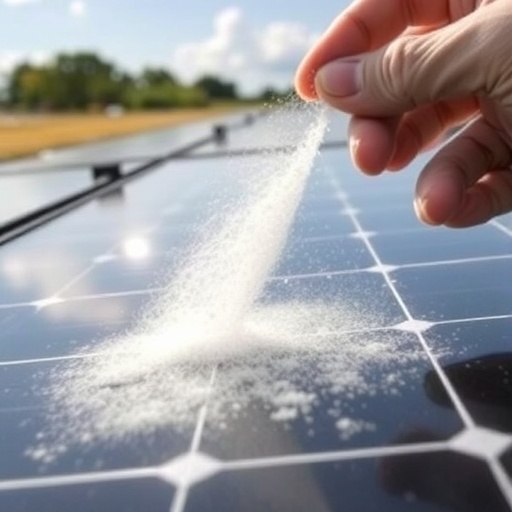Research into the effects of dust on solar panels has become increasingly pertinent as the demand for renewable energy sources skyrockets. Researchers from India have initiated an experimental study that explores innovative techniques to mitigate the adverse impacts of dust deposition on solar panel efficiency. Their findings, which can significantly influence solar energy production, underscore the need for effective cleaning methods and coatings to enhance solar panel performance in dusty environments.
Solar panels are efficient in converting sunlight into electricity, but they are highly susceptible to a multitude of environmental factors. Dust accumulation presents one of the biggest challenges, especially in arid and semi-arid regions where solar energy is harnessed most. The layer of dust that settles on solar photovoltaic (PV) panels can obstruct sunlight, significantly reducing their energy output. Understanding how to counteract this problem is critical to maximizing the performance of solar energy systems across various climates and geographical locations.
The team led by researchers Kumar, Yadav, and Chaudhary approached this issue by examining two novel methods: hydrophobic coatings and mechanical vibration. These strategies were chosen for their potential to minimize dust adherence and improve the cleaning process of solar panels. Hydrophobic coatings work by creating a surface that repels water and inhibits dust accumulation, while vibration introduces an additional method to dislodge particles that may stick to the panel surface.
In their experiments, the team meticulously designed a controlled environment to evaluate the effectiveness of these methods. Solar panels treated with hydrophobic coatings were subjected to varying levels of dust accumulation under simulated conditions. By employing high-precision optical measurements and energy output recording features, the research team was able to quantify the performance of coated versus uncoated panels.
The results of their experiments were striking. Hydrophobic coatings exhibited a remarkable ability to repel both water and dust particles. The coated solar panels maintained a higher efficiency rate in energy conversion compared to the uncoated panels, confirming the hypothesis that such coatings can be a viable solution to dust-related challenges. This revelation is not only groundbreaking but also offers a straightforward approach that can reduce maintenance costs and increase the longevity of solar energy systems.
In conjunction with hydrophobic coatings, the introduction of vibration technology was also tested. Mechanical vibration serves to dislodge dust clinging to the panel surface without the need for constant manual cleaning. The incorporation of vibration devices proved to be advantageous, as it significantly minimized the amount of dust buildup on the panels over time. This dual approach of using both vibration and hydrophobic coatings has the potential to revolutionize solar panel maintenance practices.
The implications of this research reach far beyond mere laboratory success. As countries around the world increasingly transition towards renewable energy sources, optimizing solar panel performance becomes critical. The findings could encourage stakeholders in the solar energy sector to adopt these innovative techniques, resulting in increased energy production and reduced operational costs.
Moreover, the implementation of these methods can lead to more sustainable practices within the industry. Cleaner solar panels not only generate more energy but also reduce the need for frequent cleaning interventions, which often require the use of water and other resources. This aligns perfectly with broader sustainable development goals that prioritize environmental conservation and resource efficiency.
Furthermore, the research holds significant promise for deployment in various climates globally. Countries experiencing high dust accumulation can particularly benefit from the implemented techniques, which can lead to substantial enhancements in energy yield, making solar energy a more viable and competitive solution in the global energy market.
However, while the findings are promising, further investigation is warranted before widespread adoption. The long-term durability of hydrophobic coatings under different weather conditions, coupled with the feasibility of integrating vibration systems into existing solar energy infrastructures, are areas that demand more attention. The researchers have already indicated plans for extensive field trials to further validate their experimental results.
Overall, Kumar, Yadav, Chaudhary, and their team present an exciting advancement in the effort to enhance the efficiency of solar panels. Their findings highlight the necessity for innovative solutions to tackle real-world challenges that hinder the efficacy of solar energy systems. By combining science with practical applications, this research paves the way for a brighter, more energetic future powered by renewable sources.
In conclusion, as the world increasingly grapples with the challenge of climate change and energy sustainability, innovative research is shaping the path forward. The study conducted by these pioneering researchers contributes significantly to the global dialog regarding renewable energy optimization. The marriage of hydrophobic technologies and vibrational methodologies could very well become standard in the efforts to improve solar panel performance, leading to an era where solar energy is fully capitalized upon, regardless of external environmental conditions.
This research not only represents a leap forward in solar technology but also serves as a reminder that the pursuit of knowledge and innovation is critical in overcoming the environmental challenges of our time. As we look ahead, embracing such interdisciplinary approaches will be key in achieving a sustainable and productive energy future.
Subject of Research: Dust deposition effects on solar panels and mitigation techniques.
Article Title: Mitigating dust deposition effects on solar panels: an experimental approach using hydrophobic coating and vibration.
Article References:
Kumar, H., Yadav, S., Chaudhary, A. et al. Mitigating dust deposition effects on solar panels: an experimental approach using hydrophobic coating and vibration.
Environ Sci Pollut Res (2025). https://doi.org/10.1007/s11356-025-36946-8
Image Credits: AI Generated
DOI: 10.1007/s11356-025-36946-8
Keywords: solar panels, dust deposition, hydrophobic coating, vibration, renewable energy, environmental sustainability.




